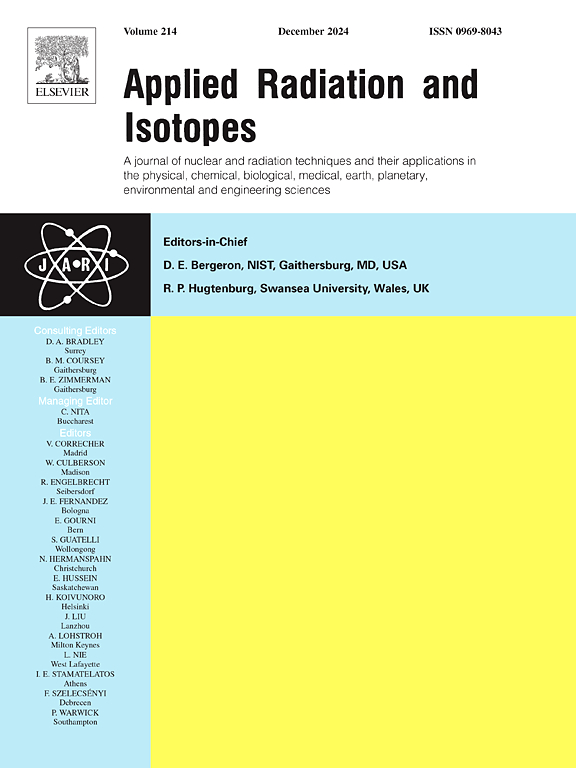Numerical dosimetry of stereotactic radiosurgery treatments in pediatric patients
IF 1.6
3区 工程技术
Q3 CHEMISTRY, INORGANIC & NUCLEAR
引用次数: 0
Abstract
Brain and nervous system neoplasms account for 25 % of childhood cancer cases. In these instances, radiotherapy treatments increase survival rates, but the high radiosensitivity of pediatric patients raises concerns about the potential adverse effects of radiation. Thus, dose delivery precision becomes crucial in treatment planning, and stereotactic radiosurgeries, such as those performed with Gamma Knife equipment, are the leading-edge techniques in precision radiotherapy. This study aims to evaluate conversion coefficients for equivalent doses (CC[HT]) for out-of-field organs using pediatric mesh-type reference computational phantoms aged 1-, 5 -, 10-, and 15-years during stereotactic radiosurgery through computational simulations with the MCNP 6.3.0 code. Higher CC[HT] values were found for organs closer to the target organ of the treatment, such as the eyes, salivary glands, and thyroid, which received an average of 33.6 %, 6.4 %, and 2.6 % of the treatment dose, respectively. As the age of the pediatric phantom increased, CC[HT] values in organs farther from the target region decreased due to the increase in body length. We also determined the conversion coefficients for effective doses CC[E] and observed higher CC[E] values for the computational phantom with the lowest BMI. Thus, computational simulations showed to be meaningful tool for estimating out-of-field CC[HT] values in pediatric patients and CC[E] values, given the challenges of performing organ-level dosimetry.
立体定向放射外科治疗儿科患者的数值剂量学
脑和神经系统肿瘤占儿童癌症病例的25%。在这些情况下,放射治疗提高了生存率,但儿科患者的高放射敏感性引起了人们对放射潜在不良影响的担忧。因此,剂量传递精度在治疗计划中变得至关重要,而立体定向放射手术,如使用伽玛刀设备进行的放射手术,是精确放射治疗的前沿技术。本研究旨在通过MCNP 6.3.0代码的计算模拟,利用1岁、5岁、10岁和15岁儿童网格型参考计算模型,评估场外器官等效剂量(CC[HT])的转换系数。靠近治疗目标器官的器官,如眼睛、唾液腺和甲状腺,CC[HT]值较高,平均分别为治疗剂量的33.6%、6.4%和2.6%。随着儿童幻肢年龄的增加,离靶区较远器官的CC[HT]值因体长增加而降低。我们还确定了有效剂量CC[E]的转换系数,并观察到BMI最低的计算型幻影的CC[E]值较高。因此,考虑到执行器官水平剂量学的挑战,计算模拟显示是估计儿科患者场外CC[HT]值和CC[E]值的有意义的工具。
本文章由计算机程序翻译,如有差异,请以英文原文为准。
求助全文
约1分钟内获得全文
求助全文
来源期刊

Applied Radiation and Isotopes
工程技术-核科学技术
CiteScore
3.00
自引率
12.50%
发文量
406
审稿时长
13.5 months
期刊介绍:
Applied Radiation and Isotopes provides a high quality medium for the publication of substantial, original and scientific and technological papers on the development and peaceful application of nuclear, radiation and radionuclide techniques in chemistry, physics, biochemistry, biology, medicine, security, engineering and in the earth, planetary and environmental sciences, all including dosimetry. Nuclear techniques are defined in the broadest sense and both experimental and theoretical papers are welcome. They include the development and use of α- and β-particles, X-rays and γ-rays, neutrons and other nuclear particles and radiations from all sources, including radionuclides, synchrotron sources, cyclotrons and reactors and from the natural environment.
The journal aims to publish papers with significance to an international audience, containing substantial novelty and scientific impact. The Editors reserve the rights to reject, with or without external review, papers that do not meet these criteria.
Papers dealing with radiation processing, i.e., where radiation is used to bring about a biological, chemical or physical change in a material, should be directed to our sister journal Radiation Physics and Chemistry.
 求助内容:
求助内容: 应助结果提醒方式:
应助结果提醒方式:


